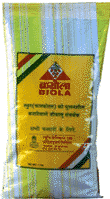Rashtriya
Chemicals and Fertilizers Ltd.
'PRIYADARSHINI', Eastern Express Highway, Sion,
Mumbai – 400 022 India.

PRODUCTS
UJJWALA (UREA)
1 |
Colour |
Crystal white |
2 |
Form |
Prilled-Free flowing |
3 |
Bulk density |
750 to 850 grams per litre |
4 |
Solubility |
100% in bottle |
5 |
Total nitrogen by wt. |
46% minimum on dry basis |
6 |
Biuret (%) by wt.maximum |
1.5%-below 1% in case of ujjwala (urea) |
7 |
Moisture |
1% maximum - below 0.2 to 0.3% in case of ujjwala |
8 |
Particle size |
90% of the material shall pass through 2.8 mm. |
9 |
Oversize |
10% maximum |
10 |
Undersize |
20% maximum |
Contains nitrogen (46%).
Nitrogen is in amide form which soluble in water. This gets converted into ammonia and nitrate subsequently absorb by plant.
Ujjwala (urea) is inert, it does not have any side effect on the soil. Hence it is suitable for use in any type of soil.
It can be successfully used along with the pesticides and insecticides, however, the mixture should be used immediately.
Apply in ridges and furrows. It can be handle by hand without gloves.
Ujjwala (urea) should be applied at the root zone of the plant.
It should be given in split doses.
Ujjwala are packed attractively in 50 kg.bags.
When crop is standing avoid broadcasting.
Its application after mixing with moist soil, neem cake avoids losses of nitrogen and improves efficiency.
a. Region wise recommendation for sugarcane (pre-seasonal) crop
Sr.NO |
Time of Application |
Ujjwala (Urea) |
1 |
Before plantation in ridges |
- |
2 |
6 to 8 weeks after plantation |
300 |
3 |
12 to 16 weeks after plantation |
75 |
4 |
20 to 22 weeks after plantation |
- |
Sr.NO |
Time of Application |
Ujjwala (Urea) |
1 |
Before plantation in ridges |
- |
2 |
6 to 8 weeks after plantation |
120 |
3 |
12 to 16 weeks after plantation |
55 |
4 |
20 to 22 weeks after plantation |
- |
Sr.NO |
Time of Application |
Ujjwala (Urea) |
1 |
Before plantation in ridges |
- |
2 |
6 to 8 weeks after plantation |
145 |
3 |
12 to 16 weeks after plantation |
70 |
4 |
20 to 22 weeks after plantation |
70 |
b. Region wise recommendation for sugarcane (seasonal) crop
Sr.NO |
Time of Application |
Ujjwala (Urea) |
1 |
Before plantation in ridges |
- |
2 |
6 to 8 weeks after plantation |
220 |
3 |
12 to 16 weeks after plantation |
55 |
4 |
20 to 22 weeks after plantation |
- |
Sr.NO |
Time of Application |
Ujjwala (Urea) |
1 |
Before plantation in ridges |
- |
2 |
6 to 8 weeks after plantation |
165 |
3 |
12 to 16 weeks after plantation |
- |
Sr.NO |
Time of Application |
Ujjwala (Urea) |
1 |
Before plantation in ridges |
- |
2 |
6 to 8 weeks after plantation |
145 |
3 |
12 to 16 weeks after plantation |
75 |
4 |
20 to 22 weeks after plantation |
75 |
c. Region wise recommendation for sugarcane (ratoon) crop
Sr.NO |
Time of Application |
Ujjwala (Urea) |
1 |
Before plantation in ridges |
- |
2 |
6 to 8 weeks after plantation |
165 |
3 |
12 to 16 weeks after plantation |
135 |
Sr.NO |
Time of Application |
Ujjwala (Urea) |
1 |
Before plantation in ridges |
- |
2 |
6 to 8 weeks after plantation |
145 |
3 |
12 to 16 weeks after plantation |
75 |
4 |
20 to 22 weeks after plantation |
75 |
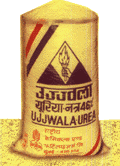
AMMONIUM NITRATE PHOSPHATE WITH POTASH
The process technology is based on three reactor system designed by KEMIRA O.Y.FINLAND to produce Suphala 15:15:15 grade with four modified spherodizers (Granular cum drier) at the rate of 1500 MT.per day.
1 |
Colour |
Reddish brown (pink) |
2 |
Form |
Granular |
3 |
Bulk density |
1100 gms. Per litr. |
4 |
Solubility |
730 GMS per litr. |
5 |
Total nitrogen (by wt.)
|
15.0% 8.0% 7.0% |
6 |
Total phosphorous (P2O5) (by wt.)
|
15.0% 4.5% 10.5% |
7 |
Potash (K2O) (by wt.) |
15.0% |
8 |
Moisture |
1.0% |
a. Recommendation for sugarcane (pre-seasonal) crop
Sr.NO |
Time of Application |
Suphala 15:15:!5 |
1 |
Before plantation in ridges |
570 |
2 |
6 to 8 weeks after plantation |
- |
3 |
12 to 16 weeks after plantation |
- |
4 |
20 to 22 weeks after plantation |
570 |
Sr.NO |
Time of Application |
Suphala 15:15:!5 |
1 |
Before plantation in ridges |
335 |
2 |
6 to 8 weeks after plantation |
- |
3 |
12 to 16 weeks after plantation |
- |
4 |
20 to 22 weeks after plantation |
335 |
Sr.NO |
Time of Application |
Suphala 15:15:!5 |
1 |
Before plantation in ridges |
570 |
2 |
6 to 8 weeks after plantation |
- |
3 |
12 to 16 weeks after plantation |
- |
4 |
20 to 22 weeks after plantation |
570 |
b. Recommendation for sugarcane (seasonal) crop
Sr.NO |
Time of Application |
Suphala 15:15:!5 |
1 |
Before plantation in ridges |
435 |
2 |
6 to 8 weeks after plantation |
- |
3 |
12 to 16 weeks after plantation |
- |
4 |
20 to 22 weeks after plantation |
335 |
Sr.No |
Time of Application |
Suphala 15:15:!5 |
1 |
Before plantation in ridges |
335 |
2 |
6 to 8 weeks after plantation |
- |
3 |
12 to 16 weeks after plantation |
335 |
Sr.NO |
Time of Application |
Suphala 15:15:!5 |
1 |
Before plantation in ridges |
385 |
2 |
6 to 8 weeks after plantation |
- |
3 |
12 to 16 weeks after plantation |
- |
4 |
20 to 22 weeks after plantation |
385 |
c. Recommendation for sugarcane (ratoon) crop
Sr.NO |
Time of Application |
Suphala 15:15:!5 |
1 |
Before plantation in ridges |
500 |
2 |
6 to 8 weeks after plantation |
- |
3 |
12 to 16 weeks after plantation |
265 |
Sr.NO |
Time of Application |
Suphala 15:15:!5 |
1 |
Before plantation in ridges |
385 |
2 |
6 to 8 weeks after plantation |
- |
3 |
12 to 16 weeks after plantation |
- |
4 |
20 to 22 weeks after plantation |
385 |
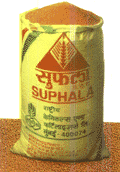
AMMONIUM NITRATE PHOSPHATE
It is manufactured with modified ODDA process supplied by Stamicarbon of Holland. The plant has been installed by M/s. Udhe of Germany1 |
Colour |
Gray |
2 |
Form |
Prilled |
3 |
Bulk density |
1050 gms./litr. |
4 |
Solubility |
800 grms./litr. |
5 |
Total nitrogen (by wt.) |
20.0% |
6 |
Total phosphorous (P2O5) (by
wt.) |
20.0% |
7 |
Moisture |
1.0% |
Suphala 15:15:15 is the only products of its kind manufacture in India.
Suphala 15:15:15 is the concentrated fertilizer containing three primary plant nutrients i.e. nitrogen, phosphorus and potash respectively.
The granules of Suphala 15:15:15 (2-4 mm) are spherical, uniform and free flowing which facilitates its even application to the soil.
The homogenous granules of the products keep the nutrients in exact
The results of trials, demonstration plot show that this is a very effective for cash crop like sugarcane.
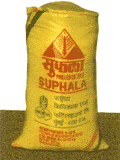
1 |
Solubility |
100% |
|
2 |
Stability |
Very high |
|
3 |
Absorption |
Faster through leaf tissues/roots |
|
4 |
Residue |
No residue |
|
5 |
Multiple nutrient |
All essential micro-nutrient present are in available |
|
6 |
Availability |
500 ML and 100 ML. Pack-bottles |
|
7 |
Product composition |
Micronutrients (In ionic forms) |
Composition in % |
Fe (Iron) |
2% |
||
Zn (Zinc) |
2% |
||
Cu (Copper) |
0.5% |
||
Mo (Molybdenum) |
0.05% |
||
B (Boron) |
0.5% |
||
Chealeating agent |
EDTA |
||
Microla Recommendation per hectare which contains Fe (iron), Zn (zinc), Cu (copper), Mo (molybdenum) and B (boron)
Time of spraying |
Microla recommendations/ha. |
1st spray- 6 to 8 weeks after plantation |
1250 ml.in 500 litrs.of water |
2nd spray- 12 to 16 weeks after plantation |
1250 ml.in 500 litrs.of water |
3rd spray- 20 to 22 weeks after plantation |
1250 ml.in 500 litrs.of water |
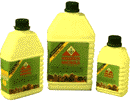
Microbial inoculants can be generally defined as preparation containing live or latent cells of efficient strains of nitrogen fixing, phosphate solubilizing or cellulolytise micro organism used for application to seed, soil or composting areas with objective of increasing number of such organisms and accelerate certain microbial process to augment the extent of availability of nutrients in a forms which can be easily assimilated by plants.
1 |
Trade name |
Biola |
2 |
Strain used |
Bacillus firmus |
3 |
Carrier used |
Lignite |
4 |
Total viable cells |
8-10/gram of the product |
5 |
pH of the product |
6.5 to 7.5 |
6 |
Free from other organisms |
|
7 |
Moisture content |
35 to 40% |
8 |
Price rate |
Rs. 45/- per kg. |
Method of application : Shown in the above statement of fertilizer application.
